Menu
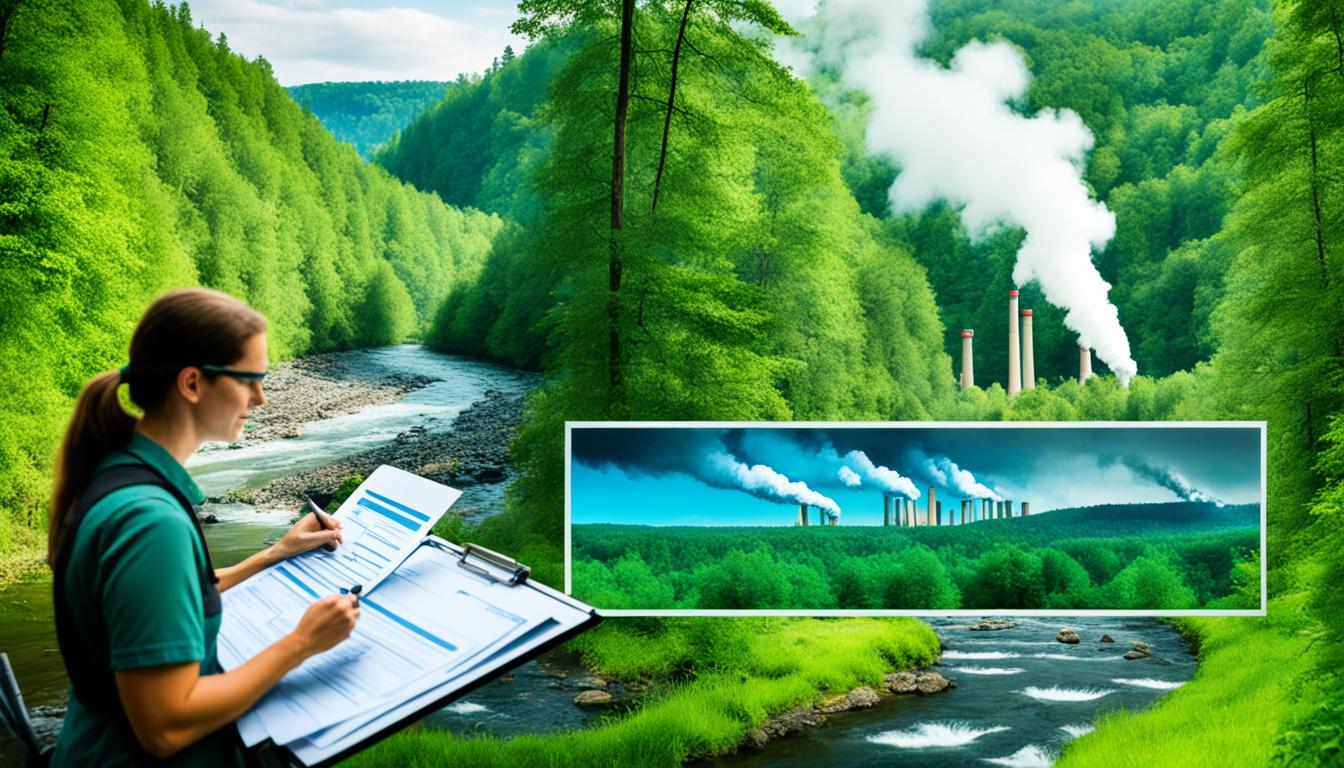
Did you know the European Union aims to heal degraded ecosystems by 2030? This is part of the 2030 EU Biodiversity Strategy. It strives to turn back ecosystem damage and increase biodiversity across Europe.
This plan includes steps like creating more protected areas. It also has a strong EU nature restoration plan to give wildlife a better chance. The goal is to help nature withstand threats like climate change and diseases that spread from animals to people. This work is part of the European Union Green Deal.
The EU is also working on a Nature Restoration Law. This law will have goals for specific places and animals. It wants to lead globally in saving nature by using big changes and better management.
The EU Biodiversity Strategy for 2030 is a key plan for nature in Europe. It aims to help the continent get back its nature and deal with big problems like climate change, forest fires, and more. The goal is to make Europe strong against these threats.
This plan wants to make more areas in Europe safe for plants and animals. It plans to do this by restoring some damaged nature spots. It also hopes to pass a law that will set specific goals for repairing nature, helping plants and animals to thrive. Commissioner Virginijus Sinkevičius thinks this plan is very important. He says it matches well with other big environmental goals.
The strategy also talks about getting more money and better rules to help nature. It wants to keep an eye on how well things are going and make smarter choices. There will be some tools online to help everyone see the progress. These tools will check how the EU and countries are doing on their goals.
This plan really wants to make a difference globally in how we protect nature. It shows the EU is serious about fighting illegal trades that hurt wildlife. This shows the EU wants to join with others to protect the planet.
The EU’s Biodiversity Strategy for 2030 sets goals to help save our wildlife. The plan wants to add more protected areas for plants and animals. It plans to make the places they already protect better too. This way, plants and animals can thrive and help our planet.
It will also try to fix places that are broken, like forests and rivers. By repairing these, we can fight climate change. This shows how important nature and fighting back against climate change work together.
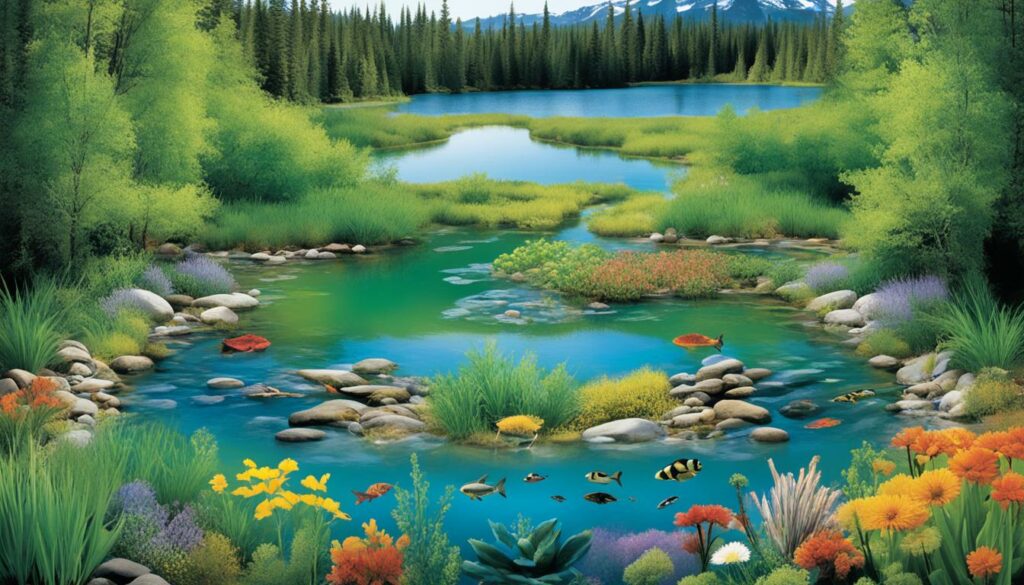
There are other big changes coming too. The EU will put more money into helping the environment. It wants to help other places around the world do better with protecting nature. This shows they want everyone to care for our planet together.
These plans are part of a big effort called the European Green Deal. They are putting tools online to check if they’re doing a good job. This makes sure everyone knows how well they are doing.
The EU is putting €20 billion each year towards these goals. This is part of their work to help nature and business at the same time. Without action, not taking care of nature would be very bad for our future and jobs.
In short, the EU’s plan wants to make sure nature can do well across Europe. It works with other countries too, for a brighter future for everyone. This way, our natural world can be enjoyed by those who come after us.
| Focus | Objective | |
|---|---|---|
| Expansion of Protected Areas | Land and Sea | Strict protection for biodiversity and climate value regions |
| Nature Restoration Plan | Restoration Measures | Revitalise degraded ecosystems capable of carbon sequestration |
| Transformative Changes | Funding and Governance | Introducing funding and improved governance for effective biodiversity conservation |
| Global Leadership | Convention on Biological Diversity | Adopt an ambitious global biodiversity framework |
| Progress Tracking | Online Tools | Actions tracker and targets dashboard for transparent monitoring |
The EU Biodiversity Strategy for 2030 focuses on making protected areas bigger. It aims to strengthen the Natura 2000 network and protect biodiversity hotspots more. This will help protect habitats and preserve Europe’s natural beauty for the future.
The Natura 2000 network already does a lot for nature. Now, it will be made better. The EU is adding more regions to Natura 2000, focusing on places with lots of plants and animals. This makes sure they are better connected and can face challenges together.
The strategy says special areas must be strictly protected. By 2030, one-third of the EU’s protected areas will get extra care. This means places like untouched forests will be looked after very well. It helps save species and keeps our environment healthy against climate change.
| Objectives | Targets | Expected Outcomes |
|---|---|---|
| Protected Areas Expansion | 30% of EU land and sea by 2030 | Enhanced biodiversity conservation |
| Strict Protection | One-third of protected areas | Improved habitat resilience |
| Natura 2000 Network | Enlarged with high biodiversity value areas | Stronger ecological networks |
To sum up, the EU takes nature protection seriously. By working together and keeping an eye on progress, it hopes to achieve a lot. The goal is to keep our planet’s landscapes beautiful and healthy for everyone.
The EU’s nature restoration plan is a key part of its Biodiversity Strategy. It aims to repair and upgrade nature through a range of projects. These efforts are designed to help ecosystems recover and protect them from climate change and disasters.
It looks at how well known plants and animals are doing, like common birds and butterflies. As we see these numbers drop and the land getting drier, taking action becomes more important. The situation has led to many species and habitats facing tough times in Europe.
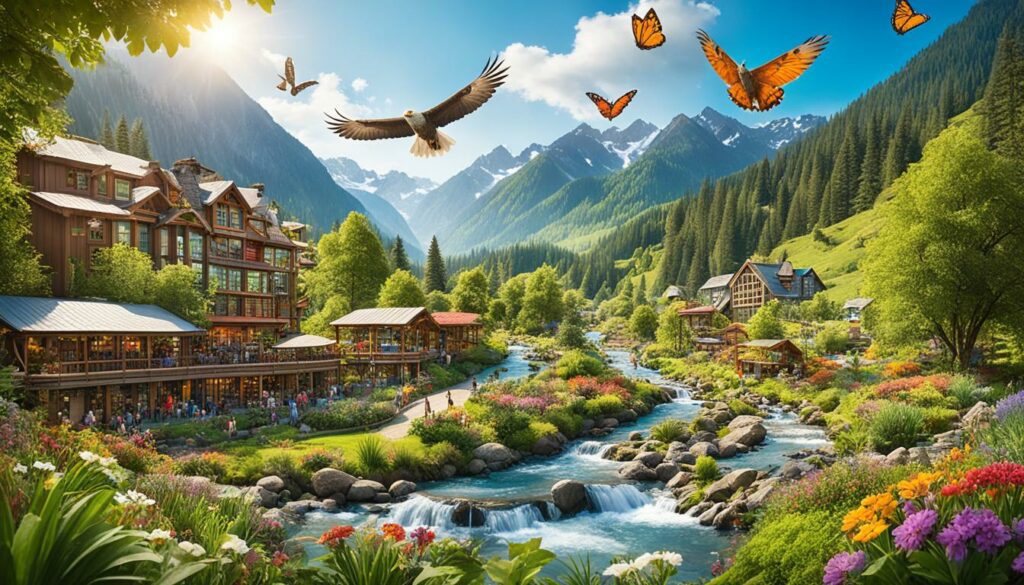
This plan is a strong stand against severe droughts hitting Europe’s nature. It shows that big steps are vital for our environment’s future health. As we move forward, the EU aims to fix 30% of its habitats by 2030. It hopes to boost this to 60% by 2040 and 90% by 2050, backed by €20 billion each year.
Recently, a law passed in the EU got wide support for fixing habitats. The future looks hopeful, with projections that this work could gain about €1.86 trillion by 2050. This far outweighs the estimated cost of €154 billion, highlighting its smart financial value.
The EU’s focus on nature restoration is clear, with solid plans and funding in place. It’s all about making sure Europe’s nature thrives despite growing environmental challenges.
The link between climate change and biodiversity is key. The 2030 EU Biodiversity Strategy targets ecological recovery. It is vital to show how resilience to climate is linked to maintaining biodiversity. This is seen through the strategy’s steps to boost ecosystem health and fight climate change.
The 2030 EU Biodiversity Strategy is all about creating resilient ecosystems. They can stand up to climate change. These ecosystems help keep a diverse range of life and balance. They act as a natural shield against extreme climate events. Notably, the strategy aims to grow the EU’s protected areas. It will also give strong protection to places of high biodiversity. This helps keep our ecosystems healthy.
Healthy ecosystems are crucial for storing carbon and cutting down greenhouse gases. The EU nature restoration plan targets places that can store a lot of carbon. This approach aids greatly in combating climate change. It supports the overall goal of reducing greenhouse gases. Measures like Natura 2000 and restoration targets are at the heart of this effort.
Here’s a snapshot of these multifaceted initiatives:
| Initiative | Details | t
|---|---|
| Network of Protected Areas | Expansion of EU-wide network, including strict protection for high biodiversity and climate value areas | t
| Nature Restoration Law | Binding targets for specific habitats and species | t
| Carbon Sequestration Focus | Revitalising ecosystems with high carbon capture potential | t
| Tracking Tools | Online actions tracker and targets dashboard to monitor strategy implementation | t
Implementing these initiatives together is crucial. It helps with environmental adaptation and builds lasting climate resilience.
Making the EU Biodiversity Strategy work needs big shifts in how we care for the environment. It also asks for new ways to pay for this work. The aim is to set up rules for green policies that really work.
The EU is trying to find a lot of money to help nature. They want to fix damaged lands and make sure the money used is good for the long run. This means making big changes to keep nature and climate in balance.

To make the strategy work, we need better ways of governing this work. There are now two online tools to help in this. One shows what’s being done, and the other checks if we’re reaching our goals.
| Governance Elements | Function | Outcome |
|---|---|---|
| Actions Tracker | Monitors implementation progress | Ensures transparency and accountability |
| Targets Dashboard | Tracks progress towards biodiversity goals | Facilitates adjustments in policies |
EU Commissioner Sinkevičius has been showing the EU’s strong interest in global nature protection at the G7. This was a big meeting about key environmental issues, where the EU’s leading role was clear. It’s a move to set good nature care rules worldwide.
“We are laying the ground for a green future with the EU Biodiversity Strategy for 2030. By stepping up nature investments and improving our rules, we will make a lasting difference.” – Virginijus Sinkevičius, EU Commissioner for Environment, Oceans and Fisheries.
The European Union leads boldly in biodiversity worldwide. It does more than just care for Europe’s environment. It also shapes a big plan for the whole world.
The EU wants nature to be strong. It has big rules to protect it. This helps in keeping nature safe all over the globe.
The EU is at the front of a big plan for nature. It aims to make more safe places, like the Natura 2000 network. These areas will get strong protection because of their rich life. Also, the EU plans to fix places where nature’s health is weak. This will help nature stay strong for the future.
Bad trading of wild animals hurts the world’s nature. The EU is strong in stopping this. It works with others around the world to stop these harmful trades. By having strict rules, the EU helps nature heal. Its plan wants to keep the earth’s homes of many animals and plants safe.
| Commitment | Objective |
|---|---|
| Expand Natura 2000 | Strict protection for high biodiversity areas |
| Nature Restoration Plan | Restore degraded ecosystems |
| Wildlife Protection Laws | Combat illegal wildlife trade |
| Global Biodiversity Framework | Lead international biodiversity agenda |
The EU has set up two smart online tools to carefully watch over biodiversity and its policies. One tool is the online actions tracker. It updates in real-time on how well actions are being carried out. This helps keep an eye on conservation efforts openly and responsibly.
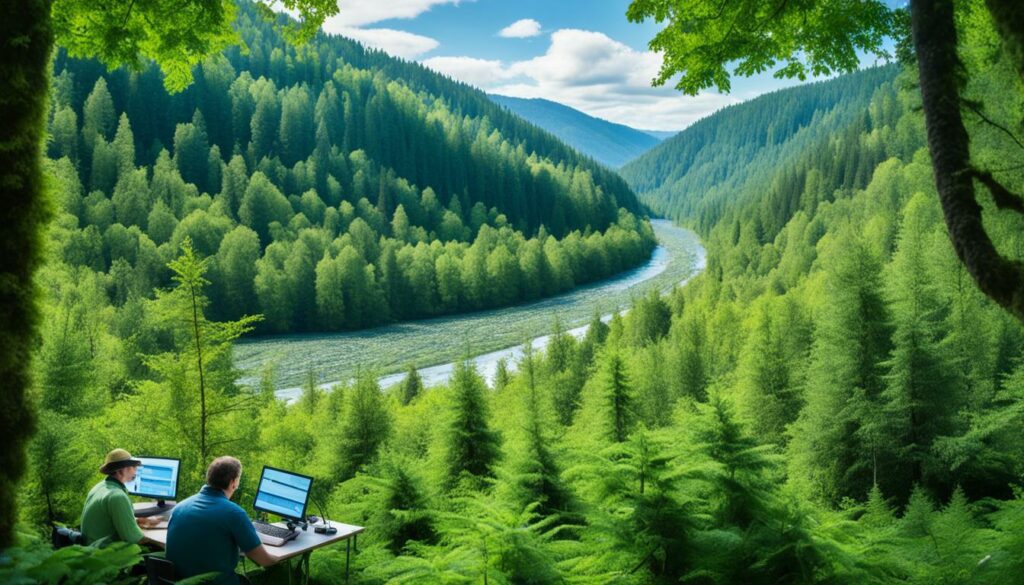
There’s also a dashboard for targets. It closely checks how the EU and its countries are doing on their biodiversity aims. This dashboard shows what’s been achieved so far and points out where more action is needed to reach the goals.
The EU is working to add more protected areas by enlarging Natura 2000 sites. The new EU nature restoration plan helps with this. It suggests ways to fix ecosystems that have been damaged. By 2030, they want to restore nature, like habitats and species, following their first Nature Restoration Law.
They are also making it easier for money and investments to flow into biodiversity. They are improving the rules and making sure nature is always considered in big decisions. All these steps help the EU keep a strong watch over its biodiversity aims. It supports the main goal of saving nature and making sure it stays strong.
Every year, conversations like the Climate, Energy & Environment Meetings of the Group of Seven in Turin, Italy, are very important. They help different countries to work together better on following environmental policies.
The Natura 2000 Award is now on its 10th year. It lets the public vote on 27 amazing finalists. This award not only celebrates great work in conservation but also gets more people interested and involved in the EU’s projects for nature.
The EU’s Biodiversity Strategy for 2030 brings big benefits to nature. One key advantage is keeping important processes running smoothly. These include things like plants pollinating, water filtering, and the earth staying fertile. They also help to regulate the climate, which is crucial for growing food and keeping us healthy.
This plan aims to make a bigger network of protected areas across the EU. It will also increase the size of already protected places like Natura 2000 areas. By doing this, it looks to protect homes for plants and animals. This keeps the environment in balance and strong against dangers. Repairing damaged landscapes, especially those that soak up carbon, is a big plus for fighting climate change.
The strategy also works to bring in more money for nature and set up better systems to manage its progress. This method helps projects for nature to run smoothly. It also helps create a new way economy to grow. A healthier variety of plants and animals opens up new jobs in caring for the environment. It supports businesses like eco-tourism and farming without harmful chemicals.
To make sure the plan is working, there are tools to watch its progress online. This keeps everyone aware and on the same page. Also, by having both the public and businesses make decisions together, nature’s needs are more likely to shape our future. This partnership makes the plan stronger.
The 2030 Biodiversity Strategy fits well with the European Green Deal and aims to keep the environment strong after the pandemic. It all adds up to a plan that helps nature, people, and businesses together. This approach stands as a key step towards an environmentally friendly Europe.
COVID-19 has shown us clearly how human health and biodiversity are linked. Destroying nature can increase the risks of zoonotic diseases. This makes it vital to respond to pandemics by saving nature. The aim is to bounce back from COVID-19 strongly, in line with the Green Deal. The goal is to create a future where we are better at avoiding threats and protecting nature.
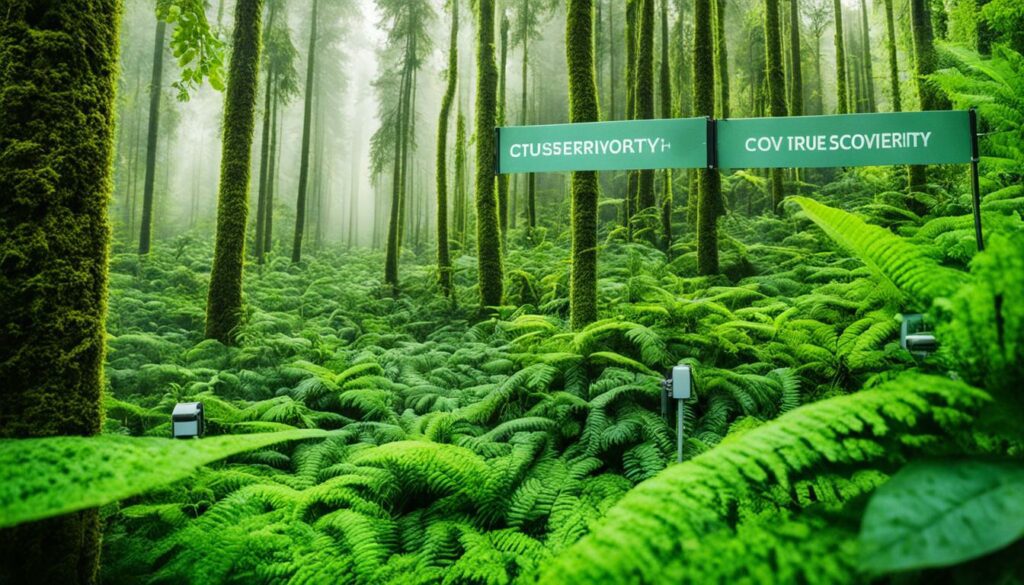
Getting better from COVID-19 should help our planet too. The EU wants to protect more natural areas like Natura 2000. It also plans to fix damaged ecosystems by 2030. This not only helps nature and fights pandemics but also boosts our economy in a sustainable way.
To prevent future pandemics, we need to make our environment stronger. The EU is working to get more money for saving nature. This will help change how we protect our planet. It aims to fight the big challenge of global biodiversity loss. These steps are key in showing others how we can lead and meet our nature-saving goals.
| EU Biodiversity Commitment | Objective | Details |
|---|---|---|
| Natura 2000 Network | Protected Areas Expansion | Strict protection for high biodiversity and climate value areas |
| Nature Restoration Law | Long-term Recovery | Binding restoration targets for specific habitats and species |
| Funding for Biodiversity | Transformative Change | Unlocking funding to support biodiversity conservation efforts |
| Global Biodiversity Framework | Leadership and Governance | Driving the successful adoption of global biodiversity commitments |
Actions on biodiversity and pandemics show a big plan connecting nature and health. The EU wants to recover from COVID-19 the right way. By focusing on the Green Deal and looking ahead, the EU is leading the way. It shows how to do a sustainable recovery while protecting nature for our future.
The junction between sustainable agriculture and food systems biodiversity is key in combating Europe’s pressing environmental issues. In 2020, 32% of Europe’s emissions came from the agriculture and food sectors. These areas have faced big economic hits from bad weather, showing how climate change affects farming. For example, in 2021, there was a €59.4 billion loss. The next year, losses were still high at €52.3 billion, underlining the need for better land management.
Europe needs to cut agricultural emissions by 40-60% by 2040 to reach net zero by 2050, the EU says. This means moving to agroecology practices. These improve how farming and nature work together and help keep a lasting ecological balance. Measures like connecting payments from the Common Agricultural Policy (CAP) to fighting climate change would aid farmers. They could then focus on helping biodiversity and being more sustainable.
Between 1995 and 2019, Germany lost over €23 million each year from winter wheat crops because of droughts. These losses show agriculture’s heavy toll on the planet. They contribute greatly to troubles like lower biodiversity, not enough water, and more greenhouse gases. And though the EU and its members are trying to lessen these problems, better, more united policies are needed.
| Year | Economic Losses in Agriculture (€ Billion) |
|---|---|
| 2021 | 59.4 |
| 2022 | 52.3 |
Agriculture in the EU accounts for 11% of all greenhouse gas emissions. This makes it essential in pushing for more sustainable ways. The Farm to Fork strategy aims to cut food waste in half by 2030. It’s a clear sign of the EU’s pledge to encourage better food habits. It also aims to tackle problems like bad diets and exposure to chemicals.
Changing Europe’s food and farming systems is crucial to avoid more harm to the environment. It’s also key for a stable future. The upcoming European Commission is called on to make the agri-food sector more eco-friendly. They need to focus on urgent and smart policies to reduce the costs of inaction.
The EU Biodiversity Strategy 2030 faces several hurdles. The lack of data and scientific knowledge is a big problem. This issue makes it hard to set good biodiversity conservation goals.
Finding enough money is also tough. There’s not always the financial support needed. Without it, even great plans can’t succeed.
The policies themselves can be tricky. Often, they don’t line up well with other EU goals. This mismatch makes it harder to protect biodiversity.
Then there’s the problem of putting conservation plans into action. Sometimes, areas for protection aren’t clearly chosen. Targets for conservation might not be set either. This lack of clear planning can slow down efforts to save habitats.

EU goals need to become part of local and national laws. But, doing this smoothly is hard. Different places show varying levels of effort and ability.
Getting everyone involved is another big issue. Sometimes, the public and those in power don’t push for change. This hurts biodiversity conservation. To do better, we all need to care more and keep up support for conservation policy.
Challenges facing the implementation of the EU Biodiversity Strategy for 2030 are diverse, encompass financial, policy, and engagement hurdles. Effective regulatory enforcement is paramount to overcoming these obstacles and ensuring the longevity and success of conservation efforts.
| Challenge Category | Description |
|---|---|
| Knowledge Availability | Lack of data and scientific understanding impacting conservation goals. |
| Funding | Insufficient financial resources allocated to biodiversity efforts. |
| Policy Coherence | Misalignment between BDS 2030 and other EU policies. |
| Management Effectiveness | Challenges in implementing effective area-based conservation measures. |
| Conservation Planning | Lack of systematic planning with transparent spatial priorities. |
| Policy Implementation | Integration issues of EU targets into national and regional laws. |
| Stakeholder Engagement | Difficulties in involving stakeholders and the public. |
| Political and Economic Systems | Short-sighted policies and limited public interest affecting biodiversity conservation. |
The EU Biodiversity Strategy 2030 aims to boost Europe’s natural beauty. It stands as a model for global efforts to protect biodiversity. The goal is to stop ecosystem losses and make sure nature thrives again all over the continent.
This strategy works to create a bigger network of protected areas across Europe. It focuses on growing the Natura 2000 network where major conservation work happens. By aiming to safeguard 30% of Europe’s lands and seas, it’s pushing hard to increase protection. This network already covered 18% of EU lands in 2019 and is getting bigger thanks to Member States’ efforts.
A key part is the EU’s plan to restore nature in damaged areas. Places like wetlands and peatlands, important for fighting climate change, are priority for restoration. The strategy makes sure there’s enough money and strong plans to achieve these goals.
The EU wants to set a good example in global biodiversity protection. With a million species at risk, it’s vital for the EU to lead. They aim to restore ecosystems around the world by 2050, focusing on both local and global ecological wellbeing.
The strategy’s success depends on everyone working together and committing to protect nature. It’s with determined support from all that the EU can ensure a vibrant natural future for Europe and the planet. This plan, part of the wider European Green Deal, paves the way for responsible nature care.
The EU Biodiversity Strategy for 2030 is an ambitious plan. It aims to stop ecosystem damage and help nature recover in Europe by 2030. This plan is key in the European Green Deal. It helps nature fight climate change, forest fires, and protect against diseases today.
This strategy is a big part of the European Green Deal. It’s all about a green recovery after COVID-19. The plan wants to make our societies strong by protecting nature. It fights different threats by being more eco-friendly.
This plan has many goals. It wants more places protected, laws to help nature recover, and money for big changes. It also aims to make sure everyone is working towards a healthier planet in the future.
The Nature Restoration Plan has clear steps to fix damaged nature. It focuses on areas that help fight climate change and prevent disasters. The plan works on making the EU’s nature on land and sea healthier in the long run.
The strategy works on making nature strong against climate issues. It plans to capture carbon naturally. This helps slow down climate change and keeps our planet in balance.
Funding for nature and stronger rules are part of the strategy. This makes sure that everyone keeps track of how well we’re doing. It helps make smart decisions about nature in both public and business areas.
The EU wants to lead the world in saving nature. It will follow global agreements and fight against illegal wildlife trading. The aim is to show the world that saving nature is crucial and to lead by example.
The EU has set up online tools to check on progress. An actions tracker and a targets dashboard help a lot. They tell us how good we are at doing the strategy and how close we are to our nature goals.
This strategy is good for many reasons. It helps keep us healthy and our food safe by protecting nature’s jobs like cleaning water and making the climate right. It’s also great for everyone’s happiness and making money in a way that doesn’t hurt the Earth.
COVID-19 showed us how important nature is for our health. The strategy fits with plans to recover in a green way. It makes sure our nature helps prevent diseases and is strong for the future.
The plan pictures a future where farms and nature work together. It wants to change how we make food, so it helps nature. This includes ideas like farming that’s good for nature and keeps old landscapes alive.
Making the plan real could be hard. We need enough money and everyone to work together. We also have to deal with how saving nature might affect jobs and other interests.